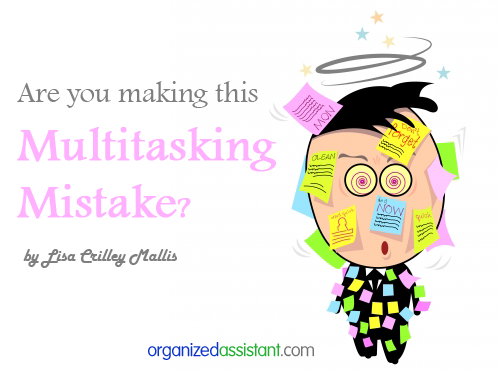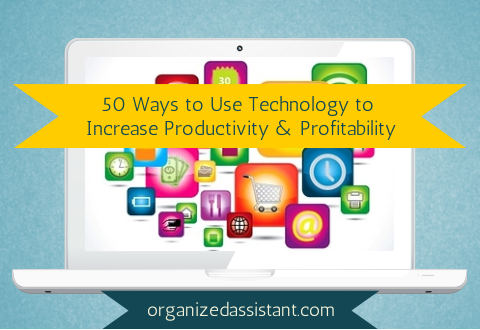Are you making this common multitasking mistake?
This page may contain links to Amazon.com or other sites from which I may receive commission on purchases you make after clicking on such links. Read my full Disclosure Policy

It’s always a pleasure when one of our Professional Organizers Blog Carnival Star Bloggers pays us a special visit, and today is no exception. Lisa Crilley Mallis from System Savvy Consulting is here with some time management advice that we can all use – because aren’t we all guilty of multitasking sometimes?

What do multitasking, switch tasking, background tasking, solo tasking all have in common? They’re all current time management buzzwords.
- Multitasking – The appearance of doing two tasks at once
- Switchtasking – Switching back and forth between two tasks
- Background tasking – Performing two or more tasks where only one requires mental effort
- Solotasking – Performing one task at a time.
Robert Pozen , author of Extreme Productivity – Boost Your Results, Reduce Your Hours, credits much of his ability to excel in a business environment to being a strong multitasker.
Yet, at a recent presentation I asked 24 women business owners if they thought multitasking was a good idea. 23 of the 24 said, “NO”. I then asked the same group if they multitasked. 21 of the 24 said, “YES”. Seems like a contradiction!
To further examine this contradiction, the group then completed an exercise where they were timed completing two tasks at once, and then timed completing each task separately. It took the group 75% – 100% longer to complete two tasks at once than to complete each task separately.
In this instance, the data “proves” that multitasking (when it is switchtasking) is NOT productive.
The question remains, “Should you – or should you not – multitask?” I believe this isn’t a clear black and white issue, but one with a cloudy grey area. To get to the answer, let’s dig a little deeper.
“Why do we multitask?”
I asked a number of my clients and colleagues who found themselves embroiled in this contradiction why they multitask. The number one reason was:
Using Multitasking to SAVE TIME –
- “I have too much to do! If I don’t try to do two things at once, I’ll never get it all done!” (Participating in a meeting and creating talking points for a later presentation.)
- “I don’t set out to multi-task, but I’m running behind, so I have to do two things at once.” (Putting on make-up while driving.)
According to Dave Crenshaw in The Myth of Multitasking, when we talk about multitasking we are actually talking about either switchtasking or background tasking. The scenarios above are all examples of switchtasking – which is NOT productive. You switch your focus from one task to the next and back again (and again, and again).
A solution I urge many of my clients to use is to implement the Rule of 1.5 (or Rule of 3) when planning. For example, if you estimate it will take you 1 hour to complete a project you have done before, schedule 1.5 hours. (You have completed this activity before, so adding 50% more time to your estimate gives you a little wiggle room if something goes wrong.)
If you think it could take you one week to complete a project that you have never completed before, schedule three weeks. (If it’s a new project, you don’t know what you don’t know , so schedule three times the amount of time! This gives you a window to learn – and implement!)
When you leave yourself a buffer in your schedule, you are able to concentrate fully on the task at hand because you aren’t feeling rushed!
I believe many successful time managers have perfected the art of background tasking, not multitasking and not switchtasking.
- Reading a book while watching the news. At first this may seem impossible – but if the only part of the news you are interested in is a story on your local elementary school – you can read a book and then shift your attention to the news when this story comes on.
- Listening to a podcast while reading reports. Again, if the only part of the teleseminar you are interested in is on social media marketing, you can read the reports, and then listen during the applicable part of the presentation.
- Signing documents while actively participating in a conference call. Now, for this to work efficiently, you cannot READ the documents, only sign them. Otherwise, this activity turns into switchtasking.
Now that you understand the examples, what do you think? Is there a difference between multitasking, background tasking, switchtasking, and solo tasking?
When do you multitask? What two (or more) activities are you doing at the same time? Why are you multitasking? How do you feel when you multitask? Please leave a comment below!
Image courtesy of Prakairoj / FreeDigitalPhotos.net




You make excellent points against multi-tasking, Lisa. Clearly defined and clearly not what to do. Isn’t it interesting how this is valued despite how it takes longer to complete tasks, and not considering the possibility of errors made when trying to concentrate on more than one thing at a time.
Moreen –
Thanks for the comment! I agree . . . we can wear our “ability” to multi-task around like a badge of honor . . . yet it’s not effective!!!!!
Lisa
It’s just like when you ask someone how they are and they answer “busy” as if it was something to be proud of.
Exactly, Janet, exactly! When I meet people at a networking event (or just chatting in “real life”) and they say “I’m so busy” I always reply, “WOW – you realize this doesn’t need to be a way of life unless you want it to be – right? I have the “Secret Solution to I’m so Busy” and we should chat!”
I “background task” all the time, but I cannot read and listen to words at the same time. For me it has to be one task to do with words and another task that is physical and routine. Example: Listen to an audio book or podcast while doing housework/yardwork/exercise. If there’s something I have to stop and read the instructions for, I have to turn off the audio first. If I don’t, I can read and comprehend the instructions, but with difficulty, and I will completely miss what was said in the audio book during that time. I have always called this “good multitasking” as opposed to “bad multitasking”. Thanks for the term “background tasking”. (Although… my examples are different from yours…is there yet another term?)
I wonder if it’s because reading and listening to words both use the same part of the brain (whichever part it is that processes language).
Hazel –
Thanks for your comment! I am envious of anyone that can listen to a podcast and do ANYTHING other than sit and take notes (I’m a visual learner, so to comprehend anything auditory I must give my complete focus to it!!) Those are perfect examples of background tasking . . . and seem to fit well with your learning style / processing modality!
I haven’t run across another term in my research. If you see one – please send it my way!
Lisa